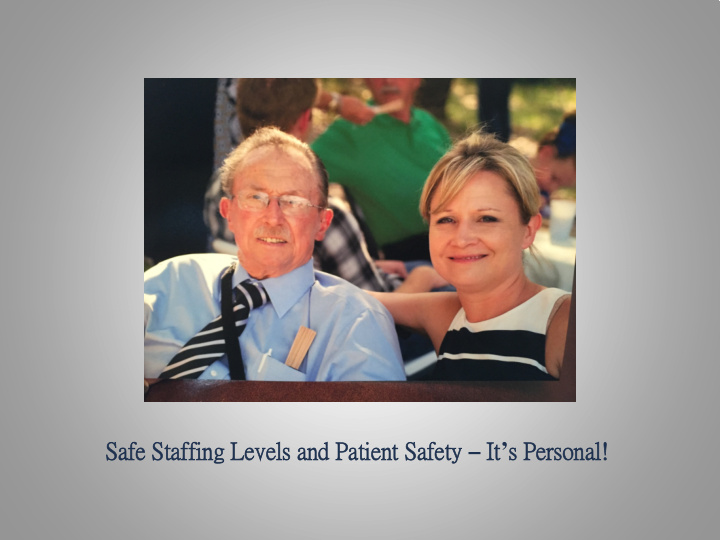



Saf Safe e St Staf affing Le Levels an and Pat Patient Saf Safet ety – It It ’ s P Persona sonal!
6 Weeks before he died
7 Days before he died 2 Months before he died
Preventable medical harm is the 3 rd leading cause of death in the U.S. Higher rate of errors are associated with nurse to patient ratios which exceed 5 patients to one nurse. For every patient above 5 assigned to a nurse, there is a 7% increase in error.
Recognize Recognize the the im impact nurse pact nurse to to patient patient ratios have ratios have on on patient saf patient safety. ety.
If I (Nurse) have 5 patients
If I (Nurse) have 6 patients
If I (Nurse) have 7 patients
Le Legisl slation 2004 California ’ s mandated ratio legislation went into effect. No other state has followed California ’ s lead in mandating specific nurse to pt ratios. 7 other states have modeled legislation after the A.N.A. ’ s Safe Staffing Principles. H.R. 1602 Rep. Jan Schakowsky of Illinois. S.864 Sen. Barbara Boxer of California
Research Linking Safe RN Staffing to Patient Patient Saf Safety ety The difference between 1:4 and 1:8 Nurse to patient ratio is approximately 1,000 deaths/year. Adding 1 patient to a nurse ’ s workload increases the odds for readmission for heart attack by 9%, heart failure by 7%, and pneumonia by 6%. Patients on an understaffed unit have a 6% higher mortality rate. An increase of 1 RN FTE per 1000 patient days reduces mortality rate by 4.3%.
Nurses Surveyed Findings from a survey conducted by Massachusetts Nurses Association in 2015: 50% report injury and harm to patients due to unders rsta taffin ffing. 61% reported medication errors due to unsafe fe p patie tient t assignments. 61% report complications for patients due to unsafe fe s staffin ffing assi signm gnmen ents. s. 81% report RNs don ’ t have time to educate patients and provide adequate discharge planning. 86% report RNs don ’ t have time to properly comfort and care for patients and families due to unsafe fe s staffin ffing assig ignments ts.
As nurses, we are the hands that touch the patients the most. Nurses are the healthcare workers delivering the majority of the care, the last safety check. How can we DEMAND better for our patients?
On May 5th, 2017, Nurses from around the country will gather to fight for the safety of our patients, our profession and the future of nursing, calling for the passage of H.R. 1602 & S. 864. We need every nurse to be in DC May 4th & 5th. Book your reservation today, bring your friends and your families.
http://nursestakedc.com/
Patients and atients and their their fam amily ily mem embers bers ’ involvem involvement ent play play a vital a vital role in role in patient saf patient safety. ety.
Don ’ t ever leave them alone
Always have people with you to hear what information you are given immediately after any procedure/surgery.
Visit loved ones in the hospital OFTEN
References: http://massnurses.org/news-and events/p/openItem/9463 http://dpeaflcio.org/wp-content/uploads/Safe-Staffing- Ratios-2013.pdf
Recommend
More recommend